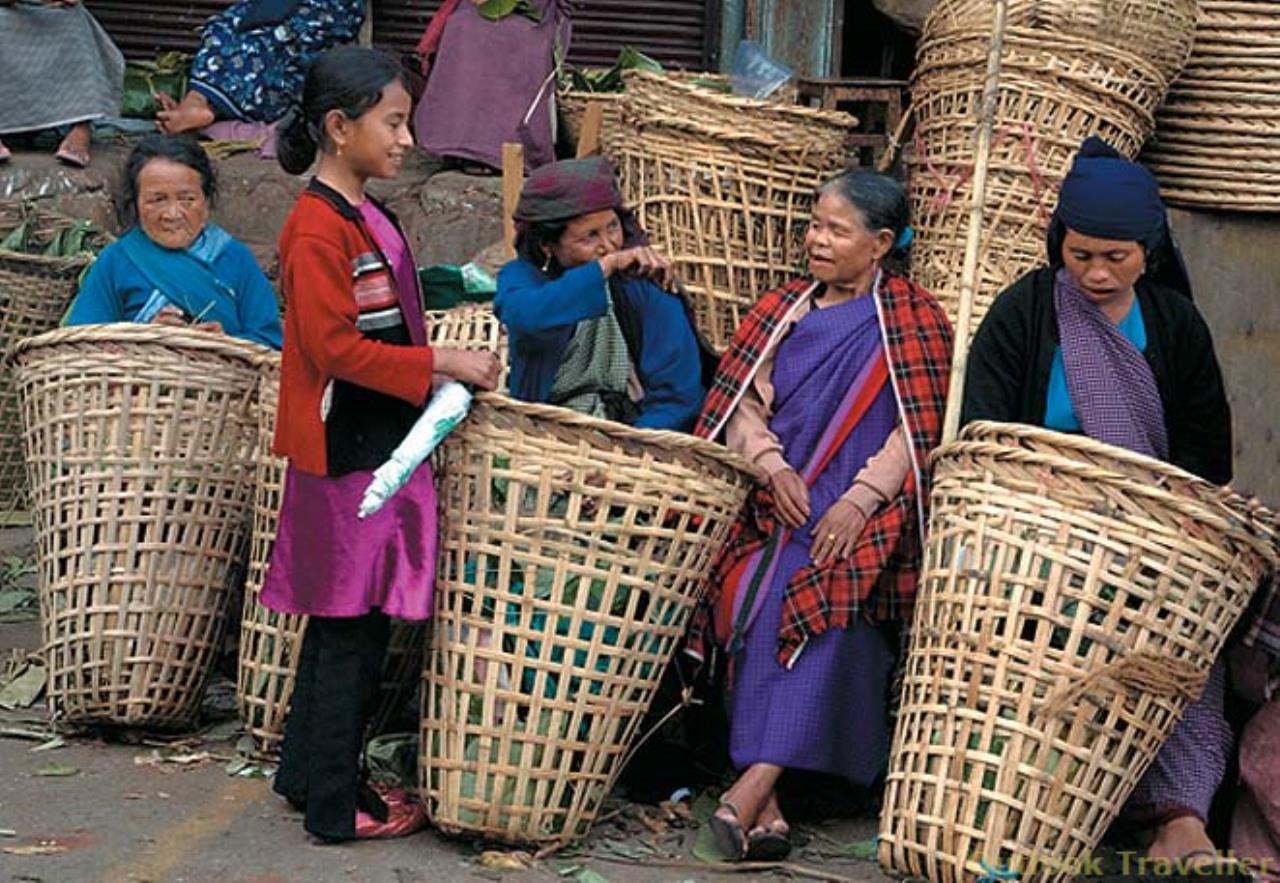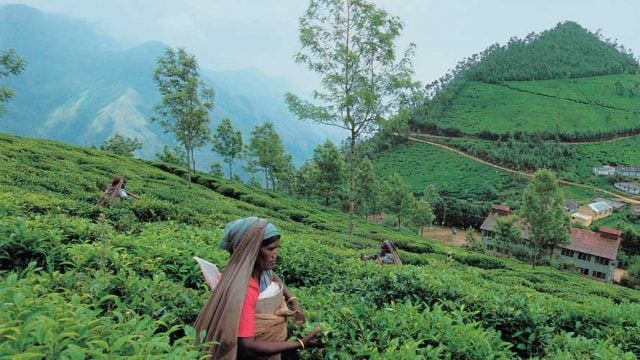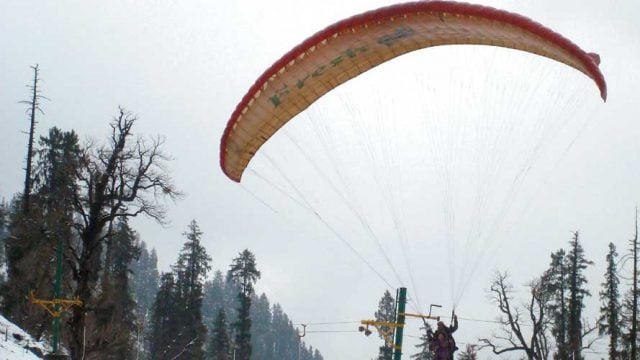On the subject of entrancing places, M.M. Kaye talks of names “that possess a peculiar, singing magic
It is best said at the outset so you can paint them into your mental frames: Meghalaya’s colours are white and green. The white of cloud and mist is “a shining and affirmative thing” but the green — the green annihilates everything “to a green thought in a green shade”. The colours form backdrop to everything — the roads, the landscapes, the ubiquitous waterfalls. The verdure is not surprising, of course, given that the small state gets an awful lot of rain. On average it receives 12,000mm each year — more than any other state.
I was hoping for rain — some vigorous showers would add much-desired verisimilitude to a monsoon travel story — but not too much. In the event, it rained quite precisely to plan. So here I was, ensconced in the beautiful resort Ri Kynjai outside Shillong, sitting out in the balcony overlooking the equally beautiful Umiam Lake, watching clouds gather. They were light-hearted at first, and light-coloured. But the grey seeped in, darkening the skies, darkening the lake, and the clouds burst all over with unabashed drama.
I drove that evening along rain-drenched hillroads with no very particular destination. I peeped into a nearby Jesuit monastery, stood at spectacular vantage points everywhere. I passed through villages, where, with only a small concession to the rain in the form of something held over their heads, people continued with chores outside. You cannot, I suppose, put off your tasks till the downpour has exhausted itself if you’ve known it to last 20 days.
Shillong was a slight surprise. A hill town, with narrow winding roads meeting big city with its buses, choked traffic and teeming office-goers. I hadn’t known it to be such a centre for education, that it attracted students from all the Northeastern states; hadn’t expected to be caught in traffic jams.
Khasi women manned the shops everywhere, their manner a nice mixture of brisk politeness. Khasis are a matrilineal tribe and tend to produce independent women. In the business centres of the city, women sped about wearing the traditional two-piece jainsem. I was very taken with the garment — it fell so gracefully, seemed to afford ease of movement and, going by the variety on Shillong’s streets, could be very smart indeed. When I walked about Police Bazaar, I looked for jainsems at the wonderful shops there. The salesgirls have coached me on how to wear them — one of these days, I mean to dazzle my friends by turning up in it.
The morning went to some tourist activity — waterfalls and peaks that make for cosy picnic spots, and I was fascinated by the sacred grove near Smit. A group of trees standing together in a stately manner, conscious of their dignity and their hallowed status. Meghalaya’s landscape is dotted with such delicious significances—there are over 80 such groves or law kyntangs dedicated to forest spirits, and several ancient stone circles and monoliths that supposedly serve as memorials.
A rare treat was in store that afternoon. Everywhere in Shillong, I had noticed small box shops, all prominently displaying a placard with four numbers printed on them. The significance was lost on me till Amar Rai of Ri Kynjai led me, with a grin, to Siat Khnam, introducing me to a lottery by archery that Meghalaya is obsessed with.
What happens is this: some 50-60 archers form an arc and shoot at a haystack for four minutes. The number of arrows is counted and the last two digits are announced. Bets are placed daily on what the numbers might be: your investment could be as little as one rupee, which could earn you eight if you’re a good guesser; the second round of shooting yields a little less — six rupees to one. There is, of course, no upper limit and bets are often placed to the tune of thousands of rupees. Fortunes are made on the teer, I was told, and the gambling is both compulsive and, as I found, terribly infectious. I placed modest sums on a clutch of favourite numbers and stood back. The archers took aim, the start was announced and a rain of arrows shot across the field, most embedding themselves in the stack. It was spectacular. It was over a few minutes later, and watchers rushed over to the betting booths, quite certain they had the right count.
The counting began, properly transparent. I moved in front to take a picture and was hastily shooed away — I had blocked the view of investors who waited like hound dogs for the verdict, keen-eyed, alert and noses aquiver. 81 and 20! Alas, one more arrow and I would’ve made a tidy sum. Phone calls were placed, SMSes went hither and thither broadcasting the numbers and I could imagine men in box shops all over the state, reaching out for their slates and writing out the fresh results — dashing hopes, making fortunes.
I made my way to Cherrapunji the following day. It has for long held the record for being the ‘wettest place on earth’ but the distinction is now regularly tossed back and forth between Cherra and neighbouring Mawsynram. I was going to stay at Cherrapunjee Holiday Resort, 17km from the town. The route was incredibly picturesque — the plains of Bangladesh lay below, obscured by swirling mists and small waterfalls gurgled here and there. Cherrapunjee Resort does not have too much by way of competition, but it does not believe in resting on its laurels for it made its presence felt throughout the 17km-stretch. Boulders advertised the joys to come — the living-root bridges, the caving adventures, the wonderful treks and went on to become increasingly ambitious: “Tourism to conserve top soil” and “Tourism for sustainable development”. There was no doubting the earnestness behind all this.
The resort turned out to be a pleasant place — modest but nicely located, with clear views of the hills around. The owner Denis P. Rayen is an interesting man with a fascinating history. Married to a Khasi, this banker from Madurai has established himself here against many odds. It was he who worked to bring the now famous living-root bridges to the attention of the world, and he relentlessly plugs Cherrapunji as a place “every meteorologist should visit at least once in their lifetime”. His agenda is two-fold: one, purely scientific, for the phenomenon of excessive rain in Cherrapunji enthrals him; the other, he wishes to help the Khasi people with alternative livelihoods.
There are a few living-root bridges here — the most interesting one, a double-decker at Nongriat would take all day to trek to but another at Ummunoi could be reached in half a day. The forest plantation engulfed us as we made our way down the steep mossy path. “The green part is slippery, madam,” my guide said helpfully. I had to bite back a laugh and the urge to ask him to show me one square inch that wasn’t ‘green’.
The bridge itself was fabulous. About 200 years old, the roots of the Indian rubber tree have been trained to grow across the stream, and they hold strong in a glorious organic network.
As we sat outdoors that evening, munching on roasted cashews with fireflies darting all around us, I tried to understand why exactly it is that Cherrapunji receives so much rain. The explanation involves moisture-laden clouds travelling unhindered for over 400km before they crash into the Khasi Hills. The orography of the region adds its twist and, as a result, Cherrapunji gets rained on rather a lot.
Leaving behind the mist-kissed cliffs of Cherra with a trace of regret, I made my way to Mawlynnong, a village almost on the Bangladesh border. My choice wasn’t random: Mawlynnong has a reputation for being the ‘cleanest village in Asia’. The Meghalaya Tourism Development Forum (MTDF) has worked hard to position the village as a rural tourism destination, going to great lengths to create tourist-friendly conditions. They have succeeded very well indeed, perhaps too well.
The guesthouse specially created for overnight guests is an utterly charming place. Raised on stilts, the hut is built with traditional materials and overlooks a thicket and small waterfall. The larger of the two accommodations has a large machan propped on the uppermost branches of a tree — a childhood dream come to life. The village is pretty: flowers bloom in every hue and in great profusion. Also, there is no denying Mawlynnong is extremely clean — the roads are metalled, a large parking lot accommodates visiting cars, a teashop does brisk business and visitors line to clamber up ‘Sky View’, a tall, bamboo tower that affords a view of the Bangla plains yonder.
For the people of Mawlynnong, I suspect this is a balancing act. They are proud, justifiably proud, of the ‘clean’ tag. Indeed Khasi households everywhere are impeccably kept. More than half the times I saw a Khasi woman throughout my stay, she would be out washing or drying clothes, or sweeping out her yard. On the other hand, they are very private. They seem to dislike being photographed and they are a subtle people, their manners complex and full of nuances. Every gesture is significant; their need for politeness is very high. To be viewed as they are, like fish in a glass bowl, must surely annoy them? Their urban visitors bring in money but they are also occasionally boorish, certainly brash by Khasi standards.
Deepak Laloo, the MTDF man behind Mawlynnong’s tourist thrust, is also concerned about how the constant interaction may change the villagers’ traditional way of living. He took me along to visit a family — friends of his —in the village. I was led hospitably indoors to sit by the kitchen fire and offered tea and slices of pineapple. The children came in from play and one ran across between us as Ba Laloo and I sat talking. He was summoned back by his elders to have his ear pinched: he had broken our line of gaze — unacceptable behaviour!
I touched down in Delhi to find that only six days in Meghalaya had altered me. I blinked at the grey, flinched at the honking and felt more than a little bewildered. The culture shock I hadn’t felt going in showed up coming back.
Monsoon in Meghalaya
Northeast India
Shillong
Leave a Reply
You must be logged in to post a comment.





